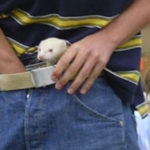 Our World
Our World  Our World
Our World  Movies and TV
Movies and TV The 10 Coolest Stars to Set Sail on The Love Boat
 History
History 10 Things You Didn’t Know About the American National Anthem
 Technology
Technology Top 10 Everyday Tech Buzzwords That Hide a Darker Past
 Humans
Humans 10 Everyday Human Behaviors That Are Actually Survival Instincts
 Animals
Animals 10 Animals That Humiliated and Harmed Historical Leaders
 History
History 10 Most Influential Protests in Modern History
 Creepy
Creepy 10 More Representations of Death from Myth, Legend, and Folktale
 Technology
Technology 10 Scientific Breakthroughs of 2025 That’ll Change Everything
 Our World
Our World 10 Ways Icelandic Culture Makes Other Countries Look Boring
 Our World
Our World 10 Ways Your Christmas Tree Is More Lit Than You Think
 Movies and TV
Movies and TV The 10 Coolest Stars to Set Sail on The Love Boat
 History
History 10 Things You Didn’t Know About the American National Anthem
Who's Behind Listverse?

Jamie Frater
Head Editor
Jamie founded Listverse due to an insatiable desire to share fascinating, obscure, and bizarre facts. He has been a guest speaker on numerous national radio and television stations and is a five time published author.
More About Us Technology
Technology Top 10 Everyday Tech Buzzwords That Hide a Darker Past
 Humans
Humans 10 Everyday Human Behaviors That Are Actually Survival Instincts
 Animals
Animals 10 Animals That Humiliated and Harmed Historical Leaders
 History
History 10 Most Influential Protests in Modern History
 Creepy
Creepy 10 More Representations of Death from Myth, Legend, and Folktale
 Technology
Technology 10 Scientific Breakthroughs of 2025 That’ll Change Everything
 Our World
Our World 10 Ways Icelandic Culture Makes Other Countries Look Boring
10 Often Misclassified Animated Characters
The animal world is filled with inspiration for animators and cartoon character designers, and often they look at little known species to avoid being cliche. Often the result is a popular character, and a lot of fans left wondering “what kind of animal is he supposed to be?” This list looks at ten examples of characters from animated movies, and it shows that there is often confusion as to their intended species. If your favorite animal character from animation is not here and you want to know the species, ask in the comments section!
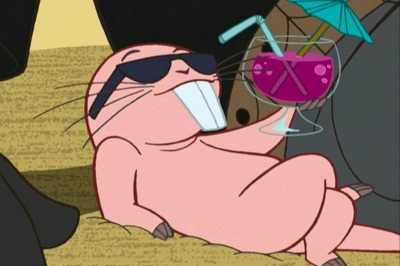
In the popular animated series Kim Possible, Kim’s sidekick Ron Stoppable has a small, super-smart, super-cute hairless pink rodent named Rufus as a pet. It was the only pet he could have as his father was allergic to anything furry (and he probably didn’t like reptiles either). At least in this case, the show did mention to which species Rufus belonged. He is a Naked Mole Rat (Heterocephalus glaber). These rodents are found in Africa, live in underground colonies ruled by a queen (just like termites!) and are nowhere near as cute as their animated counterpart.
Many fans become disappointed when they see the actual animal that inspired adorable Rufus; it has actually made it into many lists of ugly animals, even though it is a fascinating creature. Just to mention one of its remarkable traits: it has teeth that grow through the lips so it doesn’t need to open its mouth to use them (very useful if you live underground where dirt would go into your mouth all the time if you spent the day digging tunnels with your teeth). They are also cold blooded, like reptiles, and seem to be invulnerable to pain caused by acid and burning. And they have been known to dig their tunnels in concrete when put in zoo enclosures! Zoos keeping Naked Mole Rats keep them in special, reinforced enclosures. But not even these awesome traits will be enough for disappointed fans who wanted to have a cute, talking and singing Rufus of their own. In reality, Naked Mole Rats can’t survive out of their colony, which is why they are not available as pets.
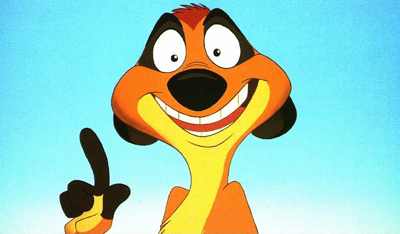
Being possibly the most successful animated movie of all time, characters from The Lion King are known to almost everyone. Nowadays, most people knows what kind of animal Timon was, since he (and his warthog mate Pumbaa) got to appear in the two sequels to the movie and got a TV series of their own. His species has been mentioned many times since. But when the movie came out for the first time, most people was left wondering what kind of animal Timon was. Some said it was a weasel, a ferret, and when I first saw the movie, I was convinced it was a Banded Mongoose. Turns out I was close; Timon is a meerkat (Suricata suricatta), a small mongoose species found in the Kalahari Desert of Africa.
Meerkats feed on insects and larvae (just like Timon), and even on scorpions and lizards sometimes. They live in groups where there is always a sentry watching for predators while the others feed; if the sentry gives an alarm call, the other meerkats run into their burrows immediately. This behavior was portrayed in The Lion King 1/2, the second sequel to The Lion King. It must be noted that, even though Timon seems to walk on two legs most of the time, meerkats are quadrupedal and only adopt a standing posture to watch their surroundings.
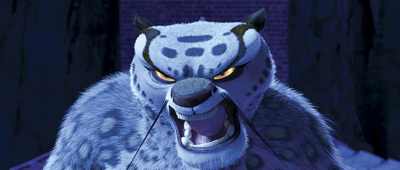
The immensely powerful villain in Kung Fu Panda has been called “a tiger”, “a jaguar”, and even “white cheetah” by both misinformed fans and the press.
In reality, he was a Snow Leopard. Snow Leopards are among the least known large predators in the world; they may look like leopards due to their spotted fur, but they are actually the closest living relatives to Tigers, according to recent genetic studies.
They live in the snowy mountains of Central Asia, and are seldom seen in the wild. Unlike other big cats, they don’t seem prone to attacking people, although they are still feared in their native lands. Being one of the few natural predators of the Giant Panda (they have been known to hunt panda cubs, especially when they wander away from their mother), it was only natural that this beautiful cat ended up being the antagonist in this successful film.
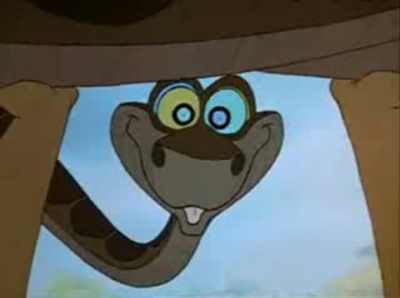
Kaa the snake is one of the most famous characters from both Rudyard Kipling’s novel, The Jungle Book, and the numerous film adaptations that have followed. Probably, most people remember him best after his 1967 appearance in Disney’s animated version of the story. Kaa was depicted in this movie as a villain, instead of a friend as in Kipling’s novel, and was given the ability to hypnotize prey by simply making eye contact with them. (It didn’t seem to work on tigers, though). But even though the character may be well known, many people still refer to Kaa as a “boa constrictor” or “anaconda”. The fact that Kaa was portrayed by an actual anaconda in one of the live action film versions didn’t help either.
In reality, Kaa is an Indian Python (Python molurus), also known as an Asian Rock Python or Burmese Python. Kipling stated that Kaa was around 9 meters long, which makes him an exceptionally large specimen, since most Indian Pythons usually don’t grow over 6 meters long. Often seen in zoos, private collections and in the movies (since they are large and spectacular but relatively docile compared to other large pythons), Indian pythons are sadly becoming rare in their native territories due to hunting, excessive collecting for the pet market, and habitat destruction.
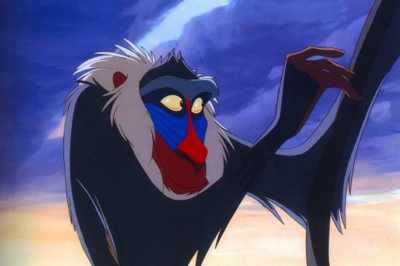
Yet another Lion King character, Rafiki (whose name means “friend” in Swahilli) does not actually belong to any real species. He is officially referred to as a baboon, and at some point of the movie he implies that himself. However, he seems to be a mix between a baboon and a mandrill (having the long tail and large mane of a baboon, but the colorful nose, cheeks and buttocks of a mandrill). In reality, Mandrills are not found in open plains and are native to the jungles of western Africa, far away from the Lion King’s “Pridelands” which are supposed to be located in the Serengeti.
Interestingly, in a later Disney movie, Tarzan, a huge troop of Rafiki-like monkeys, with mandrill-like faces but baboon-like manes and tails, are among the dangerous fauna faced by the film’s hero. Why Disney animators end up using these baboon-mandrill hybrids as replacements for actual baboons and mandrills, is anyone’s guess, but we have to recognize that the result looks kinda cool.
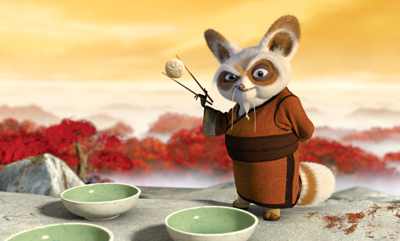
The wise and strict martial arts trainer to the Furious Five, in Kung Fu Panda, has been misidentified by fans as a fox, a raccoon, and even a mouse!
In reality, he is a Red Panda. Red Pandas (Ailurus fulgens) are raccoon-like animals with bright orange-red fur, found in the mountains of China, India, Nepal and some other Asian countries. They feed on bamboo, just like the more famous Giant Panda. There was a time in which both animals were thought to be closely related; today, thanks to genetic studies, we know that the Red Panda is more related to raccoons, while Giant Pandas were actual bears (and not a bear-like, gigantic raccoon relative as was believed).

Arthur from the famous children’s show Arthur, has been ranked as one of the most popular animated characters of all times… and still, there are lots of people who don’t know what animal is he supposed to be. Some believe he is a bear, or a capybara (a giant South American rodent). In reality, he is supposed to be an Aardvark. In the Arthur books upon which the TV show is based, he actually does look like one; he has huge ears and a long, trunk-like snout. But the show creators decided to mess with the animal’s anatomy to make it “cuter”; they reduced his ears and made them rounder, and they got rid of his snout completely. The result looks like a weird, spectacle-wearing bear thing. It is kind of sad, since the Aardvark is a very interesting animal that doesn’t get much attention in animation these days. Aardvarks are found in Africa and feed mostly on termites; they are the last living members of a once abundant group of prehistoric mammals.
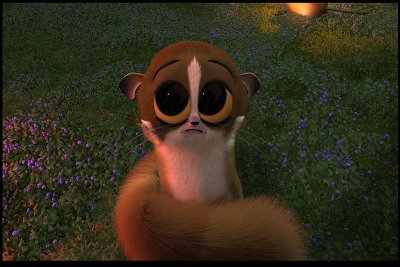
It is quite obvious that Mort, the small, fluffy, huge-eyed character in the Madagascar films, was designed to make the audiences go “Aaaaaw!” even though King Julien, the ring-tailed lemur, thought he was utterly annoying. But even though audiences did go “Aaaaaw!”, they were also left wondering what kind of animal Mort was. Most people thought it was a squirrel, while others referred to him as a mouse or a tarsier. In reality, Mort is meant to be a Mouse Lemur, specifically a Pygmy Mouse Lemur (Microcebus myoxinus), one of the smallest primates in the world. These nocturnal animals use their huge eyes to find prey (insects and small vertebrates, although they also eat fruit and tree sap) at night. They are only found in Madagascar and are probably endangered due to habitat destruction.
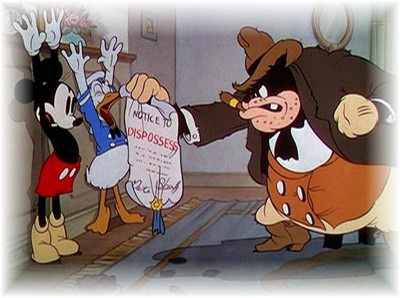
The Mickey Mouse Universe is really weird and disturbing if you think about it. It is populated mainly by dog-human hybrids; Goofy is obviously based on a dog, and his pal Mickey Mouse is freakishly big for a rodent and keeps an actual dog as a pet. Therefore, it shouldn’t be that surprising that Mickey’s arch-nemesis is not a bulldog, or a hippopotamus, or a bear, or whatever people usually (and understandably) think he is. He is actually a cat.
It was only natural for Disney to have a cat as a foe to Mickey Mouse. In some early cartoons, such as Steamboat Willie (1928) you can even see his pointy ears and long feline tail (the cartoon also depicts a normal cat which is tormented by Mickey!). Eventually, however, Pete became bigger and rounder, lost almost all of his feline traits (except for his pointy ears), and now many people has no idea of what animal is (although most seem to think of him as a dog). But since he actually acts like a human, as do Mickey and all his freaky friends, it would probably be just the same if he really was a bulldog or a hippopotamus…
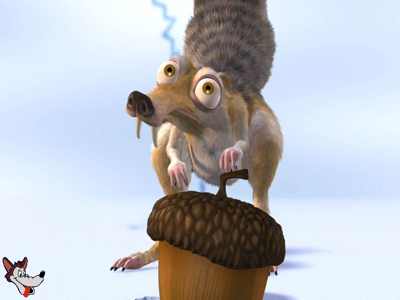
Although officially described as a “Saber toothed squirrel”, this incredibly popular creature from the Ice Age movies doesn’t belong to any known species, living or prehistoric. His obsessive love for acorns has helped define him as “some sort of squirrel” to most people, but look a little closer and you will realize he is obviously no squirrel.
According to some, Scrat was invented by a cartoon designer, inspired by a rat-squirrel hybrid she saw in New York’s Central Park (hence the original name Sqrat). However, some have suggested that he may have been inspired by a prehistoric animal named Leptictidium, which was bipedal, like Scrat, and had a long snout (but no saberteeth). Some have also stated that his physical appearance is suspiciously reminiscent of Wile E. Coyote, another obsessive cartoon mammal with a long record of painful accidents. Whatever his origins were, one thing is for sure; Scrat may very well be the most successful silent comedian of the last decades. Does it really matter what species he belongs to?
